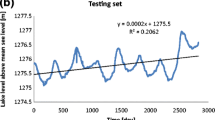Abstract
Weirs are a type of hydraulic structure used to direct and transfer water flows in the canals and overflows in the dams. The important index in computing flow discharge over the weir is discharge coefficient (C d). The aim of this study is accurate determination of the C d in triangular labyrinth side weirs by applying three intelligence models [i.e., artificial neural network (ANN), genetic programming (GP) and extreme learning machine (ELM)]. The calculated discharge coefficients were then compared with some experimental results. In order to examine the accuracy of C d predictions by ANN, GP and ELM methods, five statistical indices including coefficient of determination (R 2), root-mean-square error (RMSE), mean absolute percentage error (MAPE), SI and δ have been used. Results showed that R 2 values in the ELM, ANN and GP methods were 0.993, 0.886 and 0.884, respectively, at training stage and 0.971, 0.965 and 0.963, respectively, at test stage. The ELM method, having MAPE, RMSE, SI and δ values of 0.81, 0.0059, 0.0082 and 0.81, respectively, at the training stage and 0.89, 0.0063, 0.0089 and 0.88, respectively, at the test stage, was superior to ANN and GP methods. The ANN model ranked next to the ELM model.





Similar content being viewed by others
References
El-Khashab A, Smith KVH (1976) Experimental investigation of flow over side weirs. ASCE J Hydraul Div 102:1255–1268
De Marchi G (1934) Essay on the performance of lateral weirs. L’Energia Electtrica 11(11):849–860 (In Italian)
Borghei SM, Parvaneh A (2011) Discharge characteristics of a modified oblique side weir in subcritical flow. J Flow Meas Instrum 22(5):370–376
Kumar S, Ahmad Z, Mansoor T (2011) A new approach to improve the discharging capacity of sharp-crested triangular plan form weirs. J Flow Meas Instrum 22(3):175–180
Wormleaton PR, Tsang CC (2000) Aeration performance of rectangular plan form labyrinth weirs. ASCE J Environ Eng 126(5):456–465
Emiroglu ME, Baylar A (2005) Influence of included angle and sill slope on air entrainment of triangular plan form labyrinth weirs. ASCE J Hydraul Eng 131(3):184–189
Emiroglu ME, Kaya N, Agaccioglu H (2010) Discharge capacity of labyrinth weir located on a straight channel. J Irrig Drain Eng 136(1):37–46
Subramanya K, Awasthy SC (1972) Spatially varied flow over side weirs. ASCE J Hydraul Div 98(1):1–10
Swamee PK, Santosh KP, Masoud SA (1994) Side weir analysis using elementary discharge coefficient. J Irrig Drain Eng 120(4):742–755
Bagheri S, Heidarpour M (2010) Application of free vortex theory to estimate discharge coefficient for sharp-crested weirs. Biosyst Eng 105(3):423–427
Emiroglu ME, Kisi O, Bilhan O (2010) Predicting discharge capacity of triangular labyrinth side weir located on a straight channel by using an adaptive neuro-fuzzy technique. Adv Eng Softw 41(2):154–160
Bonakdari H, Baghalian S, Nazari F, Fazli M (2011) Numerical analysis and prediction of the velocity field in curved open channel using artificial neural network and genetic algorithm. Eng Appl Comput Fluid Mech 5(3):384–396
Emiroglu ME, Kaya N, Agaccioglu H (2010) Discharge capacity of labyrinth weir located on a straight channel. J Irrig Drain Eng 136(1):37–46
Bilhan O, Emiroglu ME, Kisi O (2010) Application of two different neural network techniques to lateral outflow over rectangular side weirs located on a straight channel. Adv Eng Softw 41(6):831–837
Huang GB, Zhu QY, Siew CK (2004) Extreme learning machine: a new learning scheme of feed forward neural networks. Int Jt Conf Neural Netw 2:985–990
Hornik K (1991) Approximation capabilities of multilayer feedforward networks. Neural Netw 4:251–257
Leshno M, Lin VY, Pinkus A, Schocken S (1993) Multilayer feedforward networks with a nonpolynomial activation function can approximate any function. Neural Netw 6:861–867
Huang GB, Babri HA (1998) Upper bounds on the number of hidden neurons in feedforward networks with arbitrary bounded nonlinear activation functions. IEEE Trans Neural Netw 9(1):224–229
Tamura S, Tateishi M (1997) Capabilities of a four-layered feedforward neural network: four layers versus three. IEEE Trans Neural Networks 8(2):251–255
Huang GB (2003) Learning capability and storage capacity of two hidden-layer feedforward networks. IEEE Trans Neural Netw 14(2):274–281
Huang GB, Zhu QY, Siew CK (2006) Extreme learning machine: theory and applications. Neurocomputing 70:489–501
Liang NY, Huang GB, Rong HJ, Saratchandran P, Sundararajan N (2006) A fast and accurate on-line sequential learning algorithm for feedforward networks. IEEE Trans Neural Netw 17:1411–1423
Smith M (1993) Neural Netw for statistical modeling. Van Nostrand Reinhold, New York
Dawson CW, Wilby R (1998) An artificial neural network approach to rainfall-runoff modelling. Hydrol Sci J 43(1):47–66
Kisi O, Emiroglu ME, Bilhan O, Guven A (2012) Prediction of lateral outflow over triangular labyrinth side weirs under subcritical conditions using soft computing approaches. Expert Syst Appl 39:3454–3460
Koza JR (1992) Genetic programming: on the programming of computers by means of natural selection. Bradford Book, MIT Press, Cambridge
Khan M, Azamathulla HMd, Tufail M, AbGhani A (2012) Bridge pier scour prediction by gene expression programming. Proc Inst Civ Eng Water Manag 165(9):481–493
Ferreira C (2001a) Gene expression programming in problem solving. In: 6th online world conference on soft computing in industrial applications
Ferreira C (2001) Gene expression programming: a new adaptive algorithm for solving problems. Complex Syst 13(2):87–129
Dianhui W, Huang GB (2005) Protein sequence classification using extreme learning machine. Proc Int Jt Conf Neural Netw 3:1406–1411
Author information
Authors and Affiliations
Corresponding author
Rights and permissions
About this article
Cite this article
Karami, H., Karimi, S., Bonakdari, H. et al. Predicting discharge coefficient of triangular labyrinth weir using extreme learning machine, artificial neural network and genetic programming. Neural Comput & Applic 29, 983–989 (2018). https://doi.org/10.1007/s00521-016-2588-x
Received:
Accepted:
Published:
Issue Date:
DOI: https://doi.org/10.1007/s00521-016-2588-x




